How Watches Work: What Is Carbon Fiber?
We’ve all seen watches made from carbon fiber. But, this futuristic-looking material imparts more than just aesthetical benefits to watches. It’s strong, and it’s lightweight, and, depending on your tastes, it looks pretty darn cool too. That said, what actually is it? Let’s find out!
Thankfully, it’s is one of those materials that give a lot away from the name alone. Carbon fiber primarily comprises carbon atoms bonded together into long chains or fibers. As we’ve already established, these fibers are incredibly strong and lightweight; two characteristics most welcome in watchmaking. It is around five times stronger than steel and twice as stiff. Though carbon composites are more robust and stiffer than steel, they are also lighter than steel, making them the ideal manufacturing material for many parts. Watches need to be strong to handle the rigors of everyday life. As watch collectors, we don’t usually want heavy behemoths adorning our wrists. So far, so good!
How is carbon fiber made?
Carbon fiber comes in a range of different formats, many of which you can find in the watch industry. The most commonly found formats are “sheet carbon” and “forged carbon”. Sheet carbon uses strands of carbon atoms in a yarn-like way to weave and braid the carbon fiber composite sheets. This style of carbon composite is also prevalent in the motorsport industry. For that reason, you’ll often also find it on watch dials, straps, and cases.
The raw sheets are not often used as is, though, and manufacturers will usually set the raw sheets into a stable matrix that allows them to shape and use the composite material in the required way. Most commonly, this matrix is epoxy resin. Epoxy resin is a liquid plastic that can be poured into molds and shaped however required. Since the epoxy is low density, one can create a part that is lightweight but also very strong. The carbon fibers then provide reinforcement, and the two materials combine and complement each other to create a superior composite.
OK, so what is forged carbon then?
Ahh, forged carbon. It’s definitely a “love-it-or-hate-it” material, thanks to its unique aesthetic. Forged carbon composites are essentially an upgrade to existing carbon fiber technology. Where sheet carbon uses long strands of organized carbon fibers, forged carbon goes in the opposite direction. Forged carbon composites use a “paste” of fibers mixed with an epoxy resin which is squeezed out into various forms.
…it takes minutes rather than hours.
Manufacturers mix sheets of uncured plastics with short randomly placed carbon fiber strands to create the paste. Unlike traditional carbon fiber sheets, this material does not require careful cutting and precise laying into hot press molds. Then it’s simply a case of adding heat and pressure. The result is a carbon fiber composite with the same strength and lightweight properties as traditionally created carbon fiber, but it takes minutes rather than hours. Thanks to this production method, forged carbon also lends itself to the creation of bracelets, and other, smaller parts that traditional carbon composites are not appropriate for.
When was it invented?
Forged carbon was invented back in the mid-2000s. Lamborghini teamed up with Callaway Golf Company and the University of Washington to develop the material that had beneficial uses for both automobile and golfing technology. Thankfully the material also translated well to the watch industry.
So there we have carbon fiber in a nutshell. Are you a fan? What’s your favorite watch using this futuristic material? Let me know in the comments! What to see some examples of forged carbon watches? Take a look at the Doxa Forged Carbon (a personal favorite) or the new Tag Heuer Carbon Monaco for Only Watch 2021!
Follow me on Instagram: @davesergeant




